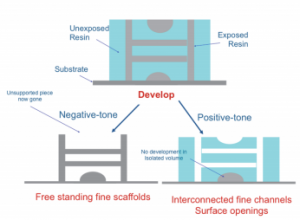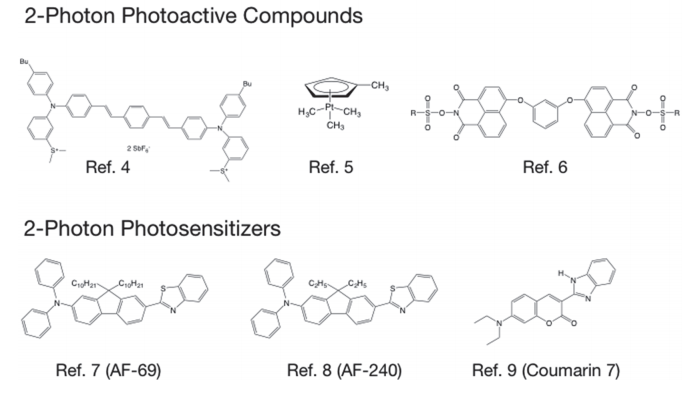 3D printing on the microscale is becoming more common as tools and materials become more sophisticated. Currently, however, most materials used in this type of 3D printing are rigid, glassy ones used in stereolithography. In a new paper entitled “Materials Overview for 2-Photon 3D Printing Applications,” a research team from Cornell University discusses the development of new materials for microscale 3D printing, particularly soft ones.
3D printing on the microscale is becoming more common as tools and materials become more sophisticated. Currently, however, most materials used in this type of 3D printing are rigid, glassy ones used in stereolithography. In a new paper entitled “Materials Overview for 2-Photon 3D Printing Applications,” a research team from Cornell University discusses the development of new materials for microscale 3D printing, particularly soft ones.
Several materials are explored and discussed in the study, including : S1) a chemically amplified photoresist, poly(tetrahydropyranyl
methacrylate-co-methyl methacrylate) with a 2-photon photoacid generator; S2) Dow Corning Silgard 182 with (n5 -cyclopentadienyl-methyl)-trimethylplatinum as photoactive material; and S3) Norland NOA 63 photocurable resin with a non-ionic 2-photon photoacid generator.
“We have also explored the use of 2-photon absorbing molecules to enhance the activity of conventional photoactive compounds that alone do
not have sufficient 2-photon photosensitivity,” the researchers state. “These include: S4) hydrogels based on poly(ethylene glycol methacrylate) and hydroxyethyl methacrylate with 2,2-dimethoxy2-phenyl acetophenone and a 2-photon sensitizer, S5) a phenolic molecular glass crosslinked with acid catalyzed TMMGU with a photoacid generator and a 2-photon photosensitizer, and S6) SU8 epoxy and thiirane analogs with an ionic PAG with a coumarin-7 2-photon photosensitizer.”
The goal of the research is to build a strong 3D structure with specific properties and structures in the range of a few microns or less. Materials were selected with regards to mechanical properties, optical characteristics, resistance to solvents including water, and surface modification characteristics. Materials needed to be able to produce a thick “film” that could be extruded smoothly but without losing its shape once extruded. Soft materials, the researchers continue, need to be handled differently than rigid materials.
“The PDMS used in S2 is a very viscous oil which contains a photoactive hydrosilylation catalyst,” they continue. “Process challenges come from the mobility of the uncrosslinked polymer and the need to develop and remove the unreacted oligomer in the negative tone process. This aspect of processing can lead to significant swelling and place large mechanical stresses on the materials.”

Representative examples of 3D patterned materials produced using 2-photon lithography a) PDMS; b) dry poly(hydroxyethyl methacrylate); c) effect of hydration on hydrogel marked with fluorescent dye
Existing photopolymer systems can be used for printing these materials, but the researchers note that the photoactive compounds (PAC) are not sufficiently active in two-photon conditions. They recommend the addition of a sensitizer that has two-photon absorbing characteristics at near-IR wavelengths.
3D printing of hydrogels can be carried out, but the reactants must be water soluble. This creates, as the researchers describe it, a complicated situation in which typically water insoluble photoactive compounds and sensitizers must be used. In the S4 system, water soluble vinyl monomers were combined with benzophenone PAC and a two-photon sensitizer that was extremely hydrophobic. To introduce these aqueous materials, surface-active compounds such as non-ionic surfactants and cyclodextrins were used.
The researchers conclude that the prospects for high speed manufacturing of 3D microprinting and complex nanostructures are improving as new two-photon-based 3D printing systems are developed. However, the materials currently lag behind the tools.
“Liquid systems are simpler to create and work with but lack the resolution of dry systems,” the researchers state. “There are not yet standard 2-photon PACs and patterning materials the way chemically amplified photoresists have consistent standardized strategies and chemistries. As these new materials and concepts develop, 3D microprinting will become much more important than it is today and will become integrated into nanomanfacturing.”
Authors of the paper include Christopher K. Ober, Ziwei Liu, Roselynn Cordero and Alicia Cintora.
Discuss this and other 3D printing topics at 3DPrintBoard.com or share your thoughts below.


268 Replies to “Study Looks at Soft Materials in 3D Microprinting With 2 Photon Lithography”
Comments are closed.